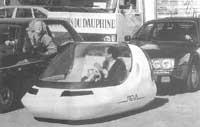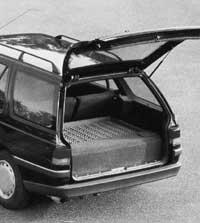Road Ready Electric Car
It is estimated that 200 thousand electric cars will circulate in Europe by 2000. Great obstacles will still have to be overcome, as there are many technical problems (see Elhuyar. In issue 40 of Science and Technology, October 1990 The Electric Car: an Endless Article), the main manufacturers present their prototypes: Peugeot Mod. 106, Citroen “AX”, Renault “Elecktro Clio”, Fiat “Cinquecenta Elettra”, Opel “Astra Impuls”, Mercedes 190-4, etc.

Although Fiat sells its electric car in Italy to about two and a half million pesetas, the rest of the brands are not sold until 1995. The company PSA, belonging to the Peugeot group, foresees the manufacture at the end of this decade of 50 thousand vehicles per year, while Fiat foresees the manufacture of 70,000 cars, with a total of 200,000 electric vehicles in Europe.
Initially they are mainly urban and suburban vehicles, with an average range of 50 km/h of 100 km, with a maximum speed of 100 km/h.
The first three steps
The proliferation of electric cars in cities will require three steps. The first is experimental and will last until 1995. During this period the reliability of new batteries will be tested so that they have the maximum volume and energy with the lowest possible weight. On the other hand, battery charging systems will also be tested in case of power failure (installation of power sockets in parks).
The second step will take place between 1995 and 2000. The current electric car models and the first “light” vehicles designed specifically for electric propulsion will be manufactured.
The third step will take place around 2000 and the electric car will leave the city, competing with gasoline cars with automatic battery charging. They will be thermal/electric cars and the driver will choose the electric or gasoline engine.
Electric motor

The electric motor is practically unnecessary. Because without polluting the air has an unbeatable energy performance. It consists of two main parts: the fixed stator and the mobile rotor that contains it. When electrical current is circulating in the stator, electromagnetic forces are generated that spin the coil in the rotor. The rotation movement of the rotor is transmitted through a gearbox to the wheels. The transmission is much simpler than the explosion motor, as the linear backward movement should not become a turning movement with cranks and cranks.
The electric motor is very silent, since there is no explosion inside, and the vehicle is only heard the noise that the tires release with the ground. In addition, since there are no pieces that are rubbed, it can travel millions of kilometers without heating. In addition, the rotor plays the transmission shaft function and as only heat energy is lost in the gear system, the performance is usually higher than 80%. In the explosion engine only 30% of the total energy spent is used on the wheels, while the rest is wasted in friction and burnt gases.
The only option in the electric motor is to perform direct current or alternating current. Each has its advantages and drawbacks. The DC is flexible and only needs scandally an electronic variator to modulate the current intensity of the power circuits to the stator and rotor. However, you need some worn parts (brush or charcoal). They must be placed to supply electricity to the rotor and replaced by a wear of about 30,000 km.
AC motors do not contain moving parts and can travel more than 150,000 km without any repair or replacement, but require a more sophisticated electronic appearance. On the one hand, they need a picture to transform the battery's DC into alternating and on the other a microprocessor to govern the excitation of the magnetic field and the induced current from the stator. Currently, the electronic control of the motor in alternating current is worth three times more than the motor itself and in the DC motor the control and motor costs are similar.

Mercedes proposes another solution for its 190-4 model. Place the rotor outside the stator, thus achieving a higher driving force with lower turning speed. The wheels have the same speed as the motor and since there is no gearbox in the transmission, the performance is over 90%.
Battery
However, the most serious problems will be to get light and small batteries. Electrochemical energy has been stored until recently in lead batteries, but the energy/mass ratio 32 Wh/kg is too small compared to the ratio 13.300 Wh/kg of gasoline. Therefore, a minimum battery of 730 kg of lead is required for the vehicle to have a range of 100 km/h. Therefore, for one to give electrons and the other to take electrons, it is necessary a pair of light and stable elements to make the battery suitable. But research is not easy, as oxidation-reduction reactions of the battery damage electrode materials.
The lithium/fluorine ratio would reach 3,000 Wh/kg (8 kilos of batteries would be enough to travel a distance of 100 km), but both lithium and fluorine are too active to make a stable and durable battery (without corrosion).
Although theoretically you can select 5,000 pairs of chemical elements from the Periodic Table to form the battery, in practice only a few can be used. The nickel/cadmium pair is one of the most successful, since in addition to having a duration of 150,000 km, it has a relationship 58 Wh/kg, that is, it weighs half of the current batteries.
The other successful partner is sodium and sulfur. Cheaper than Ni/Cd, it has a ratio of 81 Wh/kg, but this type of batteries works at 300ºC and 10% of the energy is used to heat up before starting the vehicle. Several houses in Sweden and the United States are trying to get solid (and non-liquid) electrolyte Na/S batteries.

Another type of battery is lithium and sulfur iron, which also works at high temperature (450°C) and has an energy ratio similar to sodium/sulfur with solid electrolyte. This battery needs a large cooling system, otherwise it would reach temperatures of 2,000°C.
Two types of cars
At the end of the experimental era within a couple of years, electric cars will be on sale, but in view of the prototypes that have now been presented, two ways can be observed. The gown is European and is characterized by being a small car and light body. This is the “Citela” model presented by PSA. It has a length of just three meters and in the body only has a metal chassis. Therefore, with the battery only weighs 800 kilos. For safety, the batteries are attached to the chassis to make the set more rigid. However, “Citela” is not a car to ride fast. The average speed is 50 km/h and has batteries of 240 kilos of Ni/Cd with a range of 110 kilometers in the city.
The other way is chosen in the United States and Japan. Normal cars have been projected in moderation but in a very aerodynamic way. Nissan’s FEV (Future Electric Vehicle) model is four meters long and General Motors’ “Impact” model has performance equivalent to explosion motor cars. Starting at rest, they reach a speed of 100 km/h in 8 seconds, but with a maximum speed of 130 and 110 km/h respectively and a relatively lower average speed. The Impact model achieves a range of 88 km/h of 190 km.

Another solution designed for motorists is the construction of a two-engine vehicle. It would have explosion motor and electric motor. It would work with battery and electric motor without urban pollution and gasoline engine outside the city. Volkswagen’s “Chico” model works like this. When the speed is greater than 60 km/h the explosion engine is switched on and the electric motor is switched off at low speed. In the audio model “100 Duo” the front traction is made by the explosion engine and the rear by the electric motor.
The company PSA proposes a new path in this pair of explosion and electric motors. A diesel engine would make dynamo (that is, charge the battery) and the car would always work with battery and electric motor, obtaining an average speed of 100 km/h and a autonomy of 750 km. Another alternative would be the replacement of the diesel engine with a gas turbine, but for this there could be greater technical barriers.





